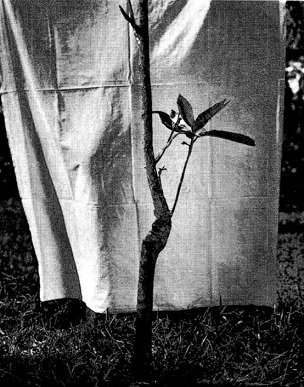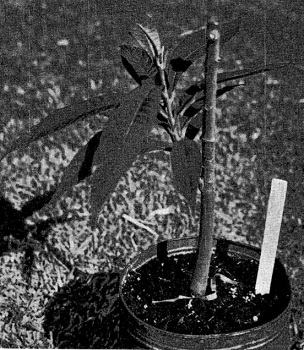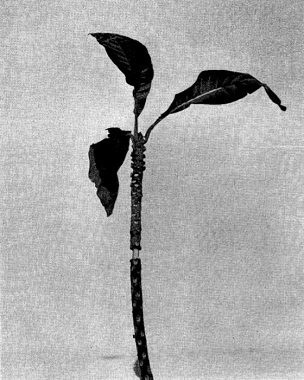The green sapote (Calocarpum viride Pittier)
is indigenous to the highlands of Central America where this handsome
large tree, with dark green foliage, reaches a height of about 40 feet.
It is considered by many to be one of the best of the Sapotaceous
fruits. Appearance-wise it resembles the mamey sapote (C. mammosum)
to which it is closely related. Features distinguishing the two are the
green sapote's smaller leaf size, its satiny brownish pubescence
covering the midribs and veins of the undersides of the leaves, its
slightly wavy leaf appearance, its rougher textured bark of the trunk
and its smaller fruit. Young seedling trees, lacking these differences
which develope with age, can be diffi cult for the uninitiated to
identify from its near "look alike twin", the mamey sapote.
A
search of records for early introductions reveals that Reasoner
Brothers (Royal Palm Nurseries) 1887-88 catalogue offered a number of
Sapotaceous fruits including the mamey sapote but no mention is made of
the green sapote. The first U.S.D.A. green sapote introduction was made
in 1913 under the botanical name of Achradelpha viridis
to be followed by five additional introductions of the same fruit in
1914. No record of their trial at the Miami, Florida U.S.D.A. Stations
was found. Further seed introductions, which were listed at the Miami
U.S.D.A. Stations, were made in 1916, 1929, 1941, and 1944. These
reached a total of 157 seeds, none of which lived to become bearing
trees. In 1929 the new name of Calocarpum viride replaced the former botanical name of Archadelpha viridis
on the station's records. Green sapote introductions at the
Sub-Tropical Experiment Station in Homestead, Florida started in 1934
with a shipment from Honduras. This was followed by three introductions
in 1946 and one each in 1948, 1950, 1956, 1959 and 1962. While all
those made prior to 1956 failed to survive, Ruehle (6) reported "Trees
8 to 10 feet tall, growing well at the Sub-Tropical Experiment Station,
were killed by flood water in 1948." From an inspection of the
available records it appears the most frequent single cause for a lack
of success with green sapote introductions was the failure of the
seeds to germinate.
 |
Fig. 1 
Die-back caused by an unidentified disease at
the graft union. All that is left of this green
sapote (Calocarpum viride) tree is the small
shoot in the foreground |
Wilson
Popenoe (3) in his Manual of Tropical and Subtropical Fruits published
in 1920, reported on page 344 "This species (the green sapote) has been
planted recently in California and in Florida. It is more likely to
succeed in the latter state than the sapote (mamey sapote), since it is
somewhat more frost-resistant. It is doubtful, however, whether it will
survive temperatures below 27 or 28 degrees above zero." Again on page
343 he states "It is most abundant in Northern Guatemala (the Alta
Verapaz), where it grows usually at elevations of 4000 to 6000 feet.
Unlike its relative the sapote, it does not thrive in the hot lowlands.
The lower limit of its cultivation is approximately 3000 feet, the
upper between 6000 and 7000 feet".
From Popenoe's remarks it
would appear that the green sapote would be more cold tolerant than the
related mamey sapote. However Campbell (2) reports "Young green sapote
trees have had higher mortality at this station (Sub-Tropical
Experiment Station) than young mamey sapote trees. There is reason to
think that they are perhaps less cold hardy than mamey sapote".
Observations by the writer would tend to confirm Campbell's statement.
In the other direction, temperature-wise, the question raised "Is
Florida too much like Guatemala's hot lowlands during the summer
months?". While this is undoubtedly a factor to be reckoned with, it
has not, in certain instances, prevented the green sapote from bearing
under South Florida's climatic conditions.
What was believed to
be the first instance of the green sapote fruiting in Florida was
reported by Whitman and Biebel (7) at the 1962 Annual Meeting of the
Florida State Horticultural Society. This related that in November 1954
Dr. Wilson Popenoe, then Director of the Escuela Agricola Panamericana
at Tegucigalpa, Honduras, sent the writer scionwood of this fruit which
was grafted on seedling stocks of the mamey sapote. In a letter dated
December 4, 1954 Dr. Popenoe (4) wrote from Honduras stating "I suspect
that is the first time anyone has made this graft". Of the trees so
grafted one at the Brooks-Tower Nursery in Homestead bore several fruit
in the late fall of 1961.
 |
Fig. 2 
Florida grown green sapote (Calocarpum viride) |
During
the autumn and winter of 1964-65 another green sapote, which came into
bearing for the first time, put on a performance that would tend to
indicate these trees are capable of producing relatively good crops
under South Florida conditions. The balance of this report is based
upon a preliminary observation of this tree and others growing in Dade
County, Florida.
 |
Fig. 3 
Green sapote (Calocarpum viride) grafted on
mamey sapote (C. mammosum) rootstock |
The green sapote can be propagated from
seed, by grafting either on itself or the related mamey sapote and
probably also by marcotting. Whether or not it will graft onto other
Sapotaceous fruits is believed untried at present. As the seeds remain
viable for only a short time after removal from the fruit they should
be planted as quickly as possible. Removing the hard shell that
surrounds the seed, prior to planting, aide germination. In grafting
success has been obtained using a side graft. Scionwood of roughly 1/2"
in diameter, girdled one or more months prior to grafting has given
good results. This is done by cutting through the cambium layer and
removing a ring of bark about 1/2" in diameter approximately 6" from
the end of the selected branch. In addition to this all leaves except
the terminal three or four are cut off. After the girdled branch swells
and the dormant buds in crease in size it is ready for grafting. It can
then be removed and cut up into shorter piece lengths to make a number
of grafts.
 |
Fig. 3 
Green sapote (Calocarpum viride) scionwood
as prepared one or more months prior to
removal for grafting |
The
green sapote, when grafted onto small seedling mamey sapote, can be
expected to reach a height of approximately 14 feet or more within ten
years and be ready to bear, assuming good cultural conditions. It is
believed the same would hold true for the green sapote on its own
rootstock, but as yet no known instance of this fruit ing as such in
Florida has been reported. The first crop to be produced by young trees
coming into bearing can run close to 75 or more fruit. However this is
usually preceded by one or more annual flowerings that fail to set any
fruit that holds on to maturity. The small white flowers are born in
profusion along the younger branches during late winter or early spring
and cross pollination from other trees is not required for fruit
setting.
In Florida the green sapote fruits from December
through March, with the main crop coming in late January. The
"top-shaped" fruit averages 2 1/2" in diameter by 3" long with a thin
brownish-green skin. The sweet reddishbrown flesh, with a pleasant
almond-like flavor contains one or two hard, large shiny dark brown
seeds. Fruit picked in advance of ripening on the tree can produce off
flavors. In commenting on this fruit Wilson Popenoe (5) wrote, "It is
really superior in flavor to the common sapote (C. mammosum), perhaps more like the sapodilla (Achras zapota). Since it seems like a cross between these two, as far as flavor is concerned, it is known in Guatemala as "injerto"—a hybrid.
When
grown on the mamey sapote as a rootstock the green sapote makes a
slightly larger diameter trunk above the graft union. An unidentified
disease has been known to attack the graft union area causing extensive
die-back above the graft. In one case what was suspected to be a fungus
disease nearly girdled the graft union. Bordeax-mixture made to a paste
consistency with spray oil added as a sticker was applied after
removing the diseased tissue, which resulted in a complete recovery.
The green sapote is also subject to attack by the Cuban May Beetle (Phyllophaga bruneri Chapin) which eats the leaves.
Green
sapote trees grafted on mamey sapote probably have identical fertilizer
requirements to the mamey sapote. Trees so grafted can maintain
satisfactory vigor on rich hammock sand soils with little or no
fertilizer after reaching bearing size. On the rocky Redlands soils of
South Dade slow decline may set in if an adequate fertilizer schedule
is not maintained. A former source of green sapote trees has been the
Brooks-Tower Nursery of Homestead, which propagated these for several
years on mamey sapote rootstocks. Seedling green sapote trees, grown
from locally produced seeds, have been offered at the annual plant sale
of the Rare Fruit Council of South Florida.
It is
suggested that the green sapote could be more widely grown in the
warmer areas of South Florida as an attractive dooryard fruit tree,
especially since it is winter bearing at a time when other tropical
fruits tend to be scarce. For those fortunate enough to already have a
ma ture mamey sapote tree, graftwood of the green sapote may be added
by top working a part of the tree. By so doing the one tree can produce
both these Sapotaceous fruits and the time taken for the green sapote
to come into bearing greatly shortened. The introduction of improved
varieties, with fruit up to 5" long (1), could even further the
desirability of this already worth while tree.
LITERATURE AND PERSONS CITED
1. Barrett, O. W. 1928. The Tropical Crops. The Macmillan Co., New York.
2. Campbell, C. W. 1965. Sub-Tropical Experiment Station. Unpublished correspondence.
3. Popenoe, W. 1920. Manual of Tropical and Sub tropical Fruits. The Macmillan Co., New York.
4. Popenoe, W. 1954. Unpublished correspondence.
5. Popenoe, W. 1965. Interesting Indigenous Fruits of Guatemala. The Garden Journal, Vol. 15, No. 2, pages 44-46, Mar, /Apr.
6.
Ruehle, G. D. 1958. Miscellaneous Tropical and Sub tropical Florida
Fruits. Bulletin 156A. Agricultural Extension Service, Gainesville,
Florida.
7. Whitman and Biebel. 1962. Rare Fruit Council Activities 1961-62. Fla. State Hort. Society, Vol. 75.